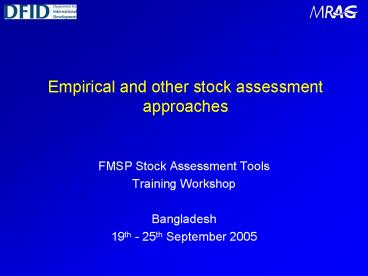Empirical and other stock assessment approaches - PowerPoint PPT Presentation
1 / 14
Title:
Empirical and other stock assessment approaches
Description:
(where M is natural mortality, K is the growth rate, tm is ... loge catch =0.9 0.096 loge area loge catch = 2.668 0.818 loge area. Section 4.7, Chapter 14 ... – PowerPoint PPT presentation
Number of Views:44
Avg rating:3.0/5.0
Title: Empirical and other stock assessment approaches
1
Empirical and other stock assessment approaches
- FMSP Stock Assessment Tools
- Training Workshop
- Bangladesh
- 19th - 25th September 2005
2
Reference points from minimal population
parameters (Beverton Holt invariants)
- Assume that a species has an average life history
pattern, with the following relationships - M / K 1.5,
- M tm 1.65, and
- Lm 0.66
- (where M is natural mortality, K is the growth
rate, tm is the age at maturity and Lm is the
length at maturity as a proportion of the
asymptotic length L8, see Chapter 11).
FAO Fish. Tech. Paper 487 Section 4.2, Chapter
11
3
Inputs and outputs from Beverton Holt
invariants method
See FAO Fish. Tech. Paper 487 Section 4.2,
Chapter 11
4
Setting fishing effort in multi-species fisheries
- FMSP Project R5484 derived guidelines for setting
F in multi-species, deep reef-slope, hook and
line fisheries - Management by size limits not practical for hook
and line fisheries - No detectable evidence of biological interactions
(competition, predation, prey release etc) - Estimate FMSY as a proportion of M, based on Lc50
and Lm for each key species (see next slide) - Set overall multi-species F as required for most
vulnerable species
Section 4.4, Chapter 12
5
Setting fishing effort in multi-species fisheries
Lm 0.5 L8
Lm 0.7 L8
Section 4.4, Chapter 12
6
Empirical approaches
- Predicting yields from other similar sites
- based on resource areas and fishing effort
- Multivariate modeling of fishery systems
- GLM approaches
- Bayesian network approaches
- See FAO Fish. Tech. Paper 487, Chapter 14
Section 4.7, Chapter 14
7
Predicting yields from resource areas, by
habitat type
- Asian river fisheries African lakes
- loge catch 0.9 0.096 loge area loge catch
2.668 0.818 loge area
Section 4.7, Chapter 14
8
Predicting yields from resource areas and fishing
effort
Maximum yield (MY) 13.2 t km-2 yr-1 132 kg ha-1
yr-1 At effort of 12 fishers km-2
For data sets FTR for FMSP Project R7834 at
http//www.fmsp.org.uk/FTRs.htm
Section 4.7, Chapter 14
9
Multivariate modelling of fishery systems
- Management performance (outcome) variables
- Production / yield / sustainability /
biodiversity - Well being of fishers / fishing households etc
- Institutional performance equity / compliance
with rules etc - Explanatory variables
- Resource / environment
- Technology fishing gear / fishing effort /
stocking etc - Community characteristics
- Management characteristics decision making
institutions etc - Fishing effort is not always the most important
factor!
Section 4.7, Chapter 14
10
Multivariate modelling methods
- General Linear Modeling (GLM) methods for dealing
with quantitative management performance
indicators (or outcome variables) such as indices
of yield or abundance - Bayesian network models for qualitative
performance indicators such as equity, compliance
and empowerment, that must be subjectively
measured or scored along with many of the
explanatory variables - Useful for adaptive management and co-management
in inland and coastal fishery systems (divisible
into resource/village units) - See Final Technical Reports for FMSP Projects
R7834 (analysis methods) and R8462 (data
collection for co-management) at
http//www.fmsp.org.uk/
Section 4.7, Chapter 14
11
Example of a Bayesian network model
- Input variables
- Output variables
- Compliance,
- CPUE change
- Equity
12
Example of a Bayesian network model
- Exploring the effects of government management on
outcomes
13
Example of a Bayesian network model
- Inputs most likely to achieve favourable states
in all three of the main management outcomes
simultaneously
14
Special approaches for inland fisheries
- Management guidelines for Asian floodplain river
fisheries - See Hoggarth et al (1999) - FAO Fish. Tech. Pap.
384/1 - http//www.fao.org/DOCREP/006/X1357E/X1357E00.HTM
- http//p15166578.pureserver.info/fmsp/r8486.htm
- Stocking models
- See analysis of eight stocking projects by FMSP
Project R6494 (summarised in Hoggarth et al,
1999, Part 2) - And forthcoming ParFish-based stocking model
- Adaptive management
- See Garaway and Arthur (2002), and other papers
from FMSP projects R7335 and R8292
(http//www.adaptivelearning.info/)
Section 4.8































